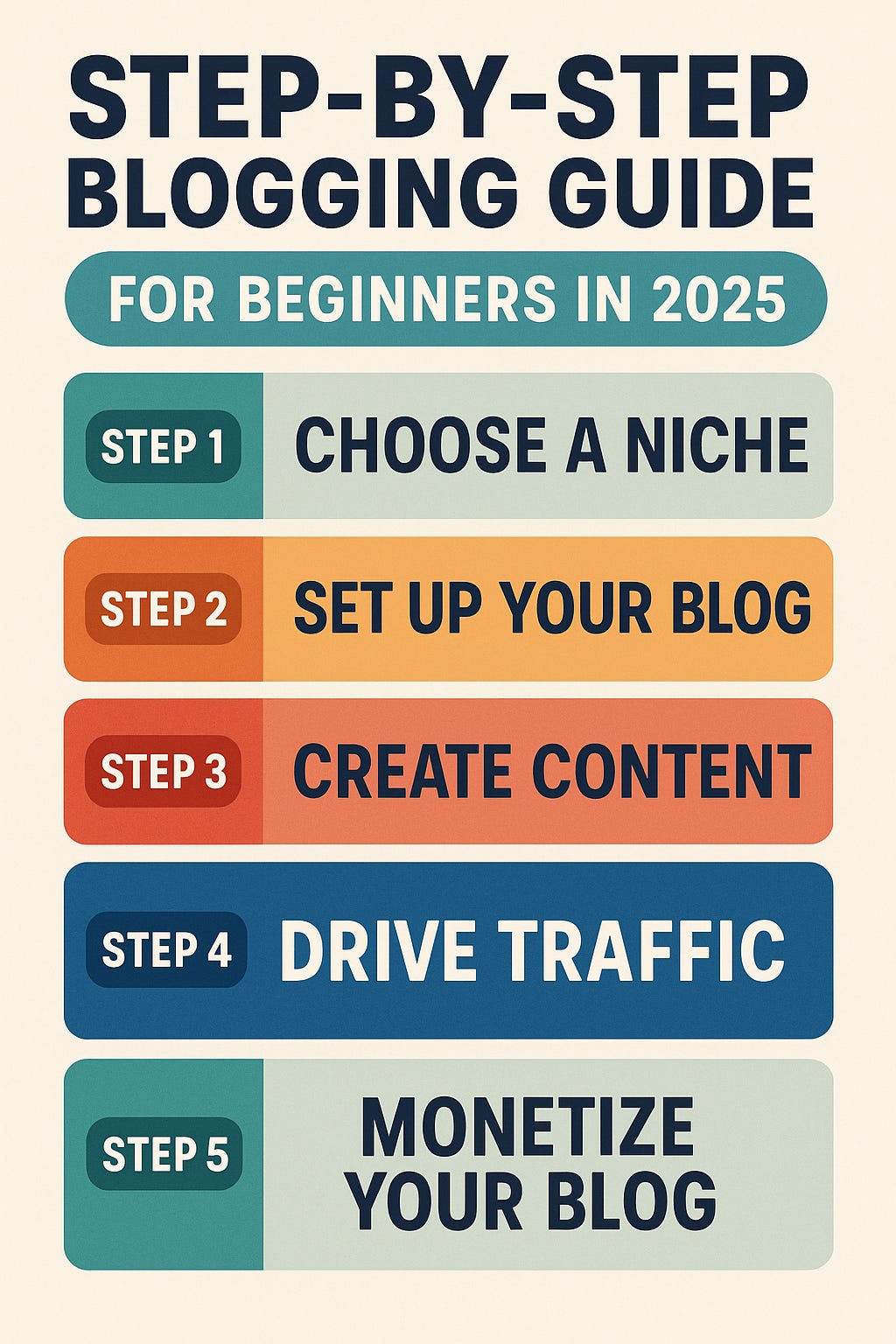Blogging for Beginners: How to Start, Grow, and Monetize a Blog in 2025
“Learn blogging for beginners in 2025. Start your blog, grow traffic, and monetize with affiliate links, ads, and products using this step-by-step guide.”
Introduction
Blogging in 2025 is still one of the most powerful ways to build an online presence, share your ideas, and make money. Despite the rise of TikTok, YouTube, and AI tools, blogs continue to dominate Google search results—and that means opportunity.
If you’re a beginner wondering how to start a blog, what tools you need, how to grow an audience, and how to eventually monetize your content, you’re in the right place.
This guide walks you step-by-step through launching your blog from scratch and building it into a money-making online business.
Section 1: Why Blogging Is Still Relevant in 2025
SEO Traffic: Blogs remain a primary way to rank in Google search.
Content Hub: Blog posts can be repurposed into videos, podcasts, and social media posts.
Monetization Options: Affiliate links, ads, digital products, memberships, and sponsorships.
Authority Building: A blog positions you as a trusted voice in your niche.
Pro Tip: Social platforms come and go, but your blog is an asset you control.
Section 2: Choosing a Profitable Blog Niche
Picking the right niche ensures your blog attracts the right audience and monetizes effectively.
Evergreen Niches:
Health & Fitness
Wealth & Finance
Personal Development
Relationships & Lifestyle
Trending Niches in 2025:
AI Tools & Automation
Remote Work & Freelancing
Green Living & Sustainability
Digital Nomad Lifestyle
Niche Selection Formula:
Passion—Can you write 50+ posts on it?
Demand—Are people searching for it? (Use Google Trends and Keyword Planner.)
Profitability—Are there affiliate programs and products to promote?
Section 3: Setting Up Your Blog Step by Step
Step 1: Pick a Blogging Platform
WordPress.org (recommended for control and SEO)
Alternatives: Wix, Squarespace, and Medium (but limited monetization).
Step 2: Choose a Domain Name
Keep it short, brandable, and easy to spell.
Example: SmartMoneyHabits.com vs. MyPersonalFinanceJourneyBlog2025.com.
Step 3: Get Hosting
Beginner-friendly options: Bluehost, SiteGround, Hostinger.
Install WordPress in one click.
Step 4: Design Your Blog
Choose a lightweight theme (Astra, GeneratePress).
Install essential plugins: RankMath or Yoast SEO, WPForms, and AWeber or ConvertKit integration.
Step 5: Publish Must-Have Pages
About Me
Contact Page
Privacy Policy
Affiliate Disclosure
Section 4: Writing Your First Blog Posts
Your blog posts are the foundation of your business.
Types of Blog Posts:
How-to Guides (step-by-step tutorials)
Listicles (Top 10 tools, Best 25 ideas)
Case Studies (showing real results)
Reviews & Comparisons (product roundups)
Beginner Tip: Aim for 1,000–2,000 words per post. Use keyword-rich titles and provide value.
SEO Checklist for Every Post:
Include the target keyword in the first 30 words.
Use H2/H3 subheadings with variations.
Add internal links to your other posts.
Use meta descriptions of ≤160 characters.
Add alt text for images.
Section 5: Growing Your Blog Audience
Traffic is where most beginners struggle. Here’s how to grow:
Free Traffic Methods:
SEO (long-tail keywords + evergreen posts)
Pinterest (pins linking back to posts)
Quora & Reddit (answer questions and link back)
YouTube videos (repurpose blog posts)
Engagement Growth:
Encourage comments by asking questions.
Reply to readers quickly.
Build an email list from day one.
Section 6: Monetizing Your Blog
Once you have steady traffic, it’s time to earn.
Monetization Options:
Affiliate Marketing—Recommend products with links.
Display Ads—Join Google AdSense or Mediavine once you have traffic.
Digital Products – eBooks, courses, templates, memberships.
Sponsored Content – Get paid to write reviews or brand features.
Email Marketing—Promote affiliate offers and your own products directly to subscribers.
Pro Tip: Focus on affiliate marketing and digital products first for the highest earnings per visitor.
Section 7: Common Beginner Blogging Mistakes
Writing without targeting keywords.
Ignoring SEO basics.
Publishing inconsistently.
Promoting too many unrelated products.
Not collecting emails from day one.
Section 8: Your Blogging Roadmap for 2025
Pick a profitable niche.
Set up your blog on WordPress.
Publish 10–15 cornerstone blog posts.
Drive traffic with SEO and Pinterest.
Build your email list.
Monetize with affiliate links and digital products.
Scale with consistent publishing and networking.
Conclusion
Blogging for beginners in 2025 is easier than ever to start—but success comes from consistency, not shortcuts. By choosing the right niche, building your site, publishing high-value posts, and applying smart traffic strategies, you can turn your blog into a long-term business.
👉Want personalized step-by-step help? Click the link below to subscribe to my Affiliate Blog Academy newsletter for free blogging strategies delivered weekly.
FAQ:
How do beginners start blogging in 2025? Pick a niche, set up WordPress, publish high-value posts, and promote with SEO and social media.
Is blogging still worth it in 2025? Yes, blogging remains one of the best ways to build authority, attract traffic, and monetize through affiliate marketing and products.
How much does it cost to start a blog in 2025? Expect $50–$100 per year for domain + hosting. Most beginners can launch for under $10/month.
How long does it take to make money blogging? Typically 6–12 months with consistent effort, but some niches can generate income faster.
What’s the best way to monetize a beginner blog? Start with affiliate marketing and digital products for higher earnings per visitor.
Stephon Anderson, email:success@therealstephonanderson.com


